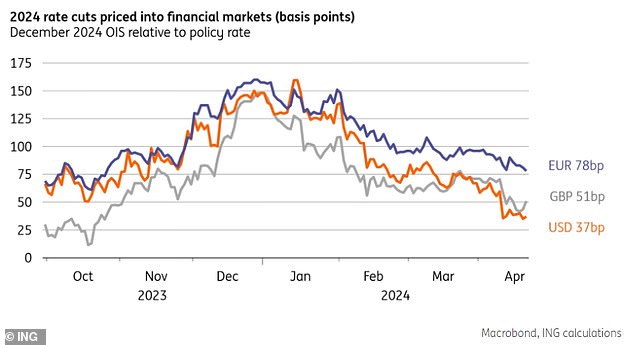Could the Bank of England leapfrog the Fed and cut rates first?
At the end of 2023, the US Federal Reserve was in an excellent position to cut interest rates. In four months, that story has been turned upside down.
Chairman Jerome Powell was forced to rule out interest rate cuts in the coming months, because consecutive economic data disappointed.
At the same time, economic indicators in the eurozone and Great Britain indicate that there is room to cut interest rates in the summer.
It has prompted markets to consider whether there could be significant differences between the Federal Reserve and other central banks.
Could the Bank of England break with tradition and ease monetary policy ahead of the Federal Reserve? Or will British households have to wait a while longer for the base rate to be lowered?
Decision point: Governor Andrew Bailey has increasingly distanced himself from British and American monetary policy
When will the Federal Reserve cut interest rates?
At the end of last year, markets were expecting about seven US interest rate cuts in 2024.
But successive data on inflation, the wage bill and retail sales threw a spanner in the works, and Powell now says it would “take longer than expected.”
Inflation has become too high for the central bank’s liking, remaining stubbornly above 3 percent at last reading. The Fed’s target rate is 2 percent.
Nominal interest rates reached 3 percent last June, the lowest figure since early 2021, but have fluctuated between 2 and 4 percent since then.
The surprise rise in inflation in February and March dashed investors’ hopes for possible rate cuts in the summer.
Markets are not considering a rate cut at the June meeting, although one is still planned for later this year, probably in the fall.
“We have revised down our expectation (since October) that the Fed will start easing in June, now in September,” said David Page, head of macro research at AXA IM. “We now expect only two more cuts this year and interest rates have risen significantly.”
ING economists also predict the first step in September, followed by further cuts in November and December.
Should the Bank of England follow the Fed?
With inflation in the US ruling out an imminent interest rate cut, attention has turned to what the British central bank could do.
The latest UK inflation figures fell from 3.4 percent to 3.2 percent between February and March. Core inflation also fell, although not as much as the headline rate, to 4.2 percent.
However, expectations for rate cuts have been scaled back in recent months as US inflation has moved higher.
There is a risk that, although the CPI has fallen, Britain could follow the US example, with inflation remaining at the 3 percent mark.
While headline inflation is expected to decline, the Bank also needs to see service sector inflation and core inflation decline.
Economists at ING say: ‘Bank of England prices have seen expectations rise more in line with the US story. Certainly, the more persistent than expected inflation figures and still higher wage growth have contributed to that sentiment.’
While Capital Economics says: ‘We think the legacy of the weaker UK economy will mean that inflation in Britain will fall further than in the US and this could be one of those rare cases where the Bank of England keeps raising interest rates earlier and further than the Fed.’
Overall, the Bank of England has followed the US in rate cuts, largely due to its sensitivity to currency weakness.

The Federal Reserve has ruled out threatening interest rate cuts as inflation remains high
Of the eight interest rate cuts since 1980, only once has Britain cut rates first, says Capital Economics.
But it’s not a hard and fast rule. ING economists say the link between Fed and BoE policies is often overstated.
“There are plenty of examples where the BoE has deviated from the Fed in a meaningful way, and the 2016-2018 US rate hike cycle is the most recent,” they say.
‘Those concerns about the impact of a weaker currency have probably faded into the background.
Whatever happens, it looks like the Bank of England is more likely to cut rates than the Fed
‘Not only is inflation much lower and there is greater confidence in the coming disinflation, the British pound has also been one of the more resilient currencies of the G10 in light of the renewed strength of the dollar. In a sense, that provides a bit of a buffer against new weakness and the pass-through of inflation.
“We don’t think the BoE will have much difficulty cutting rates at the Federal Reserve, nor will it move slightly faster in subsequent meetings.”
Ruth Gregory, deputy chief UK economist at Capital Economics, thinks the central bank could be concerned about “the potential inflationary impact of a weaker pound if it cuts rates first and further”, especially if the second round effects on inflation raise expectations and wages. .
However, she predicts that second-round effects are likely to be less likely.
‘We think UK inflation will be lower than in the US and domestic prices will have less momentum. This could mean that the Bank cuts interest rates earlier and further than the Fed. The big and obvious risk is that UK inflation trends will follow US trends.”
When will the Bank of England cut interest rates?
The inflation picture in Britain is currently very different from that in the US. It seems likely that headline interest rates will fall below 2 percent in the coming months as food and energy, previously key drivers, decline.
The 12 percent drop in household energy bills in April will drag down this month’s figures, which is likely to be followed by a further fall in costs in July.
This will increase market expectations that the BoE could start cutting rates as early as June.
Economists at ING note that Andrew Bailey has tried to put distance “between domestic monetary policy and that of the Fed, arguing that European inflation dynamics were different from those in the US, where they were more demand-led.”

They add: ‘We don’t hear from BoE officials as often as we do from their counterparts at the ECB or the Federal Reserve… the current optimism about the inflation outlook among the key BoE numbers therefore feels both intentional and meaningful. ‘
So if the central bank gets ahead of the Fed, when might we see a cut in the base rate?
Page says that ‘a rate cut in June still seems most likely, with two more cuts in September and November.
“Nevertheless, there is a risk that August will be postponed if inflation and wage growth remain above expectations.”
Economists at ING predict that inflation in the services sector could be more persistent, tipping the balance in favor of a cut in August instead of June.
Whatever happens, it looks like the Bank of England will cut rates sooner than the Fed, with the first move expected in September. We believe that the total of BoE cuts will also be greater this year.”
It could also arise from the moment when the European Central Bank (ECB) starts to cut interest rates. The mood was largely positive as economic activity begins to improve, mainly driven by the services sector, although manufacturing remains weak.
The ECB continues to signal a cut in June and markets generally agree that there will be three cuts by the end of the year.
Economists at ING say: ‘It is clear that the BoE should be positioned between the ECB and the Fed in terms of timing, and our economist’s current forecast would likely require more correction towards August as the most likely rate cut date.’
Some links in this article may be affiliate links. If you click on it, we may earn a small commission. That helps us fund This Is Money and keep it free to use. We do not write articles to promote products. We do not allow a commercial relationship to compromise our editorial independence.

